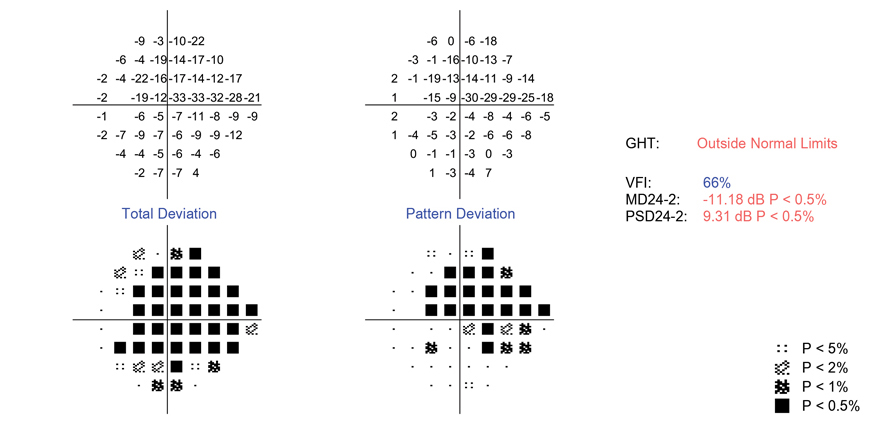 |
| Technology can now accurately gauge disease severity in glaucoma patients. Photo: Danica Marrelli, OD. Click image to enlarge. |
Recent advances in artificial intelligence (AI) have shown promise in providing an unbiased and objective method to assess visual field (VF) data, but none have explored the staging of glaucoma. Researchers recently developed unsupervised machine learning to identify different severity levels of glaucoma based on VFs generated from AI.
A total of 13,231 VFs from 8,077 subjects were used to develop models and 8,024 VFs from 4,445 subjects were used to validate those models.
The researchers applied an unsupervised clustering model to VF data and discovered four clusters of eyes with similar VF characteristics, labeling them as normal, early, moderate and advanced based on the average mean deviation (MD) of eyes in clusters and generated clinical clusters.
“Rather than using the complex unsupervised machine learning model as the severity staging system, we investigated if a simple criterion based on the readily available MD could separate these four clusters with reasonable accuracy,” the study authors explained. “To achieve this goal, we developed a supervised Bayes minimum error classifier to identify MD thresholds that discriminate these clusters with the highest accuracy. This statistical approach identifies thresholds that lead to minimum classification error among four clusters.”
They found that MD thresholds of -2.2dB, - 8.0dB and -17.3dB could stage VFs into four disease severity levels with an accuracy of 94% compared with the initial complex statistical clusters identified based on unsupervised learning.
“The misclassification rate was higher in the moderate and advanced clusters compared with other clusters which may be justified by more variability of VFs in more severe cases,” the investigators explained. “By slightly compromising the accuracy, the severity staging system is based on clinical clusters that require MD thresholds only compared with statistical clusters that require access to 52 VF test locations and performing complex unsupervised learning.”
The staging system is ultimately based on MD thresholds, which were derived based on an unbiased and objective approach that maximized staging accuracy.
“In fact, the accuracy of the staging system based on the identified MD thresholds was only 6% less accurate than the initial k-means clustering that utilized all VF test locations in identifying statistical clusters,” the researchers noted. “Given this modest difference, we did not suggest the initial k-means model as the VF staging system because the likelihood of such a complex model gaining widespread popularity and being widely used by clinicians is minimal. Instead, we have turned a quite complex k-means into a simple and easy-to-use glaucoma staging system while maintaining the accuracy at 94%.”
The authors concluded that this glaucoma staging system is highly suitable for use in glaucoma research for day-to-day clinical practice. “Unlike other VF staging models, our system is simple, easy-to-use, evidence-based and clinician-friendly,” they added.
Huang X, Saki F, Wang M, et al. An objective and easy-to-use glaucoma functional severity system based on artificial intelligence. J Glaucoma. June 3, 2022. [Epub ahead of print]. |


